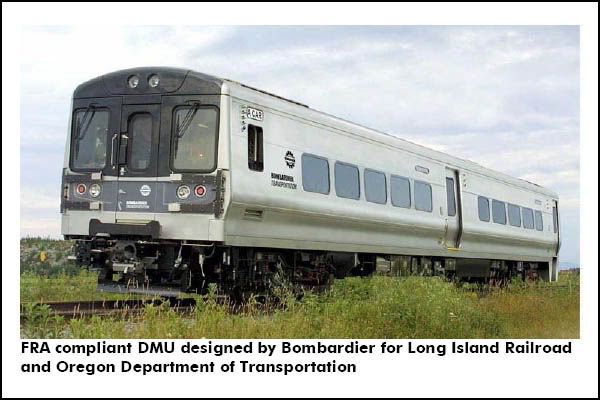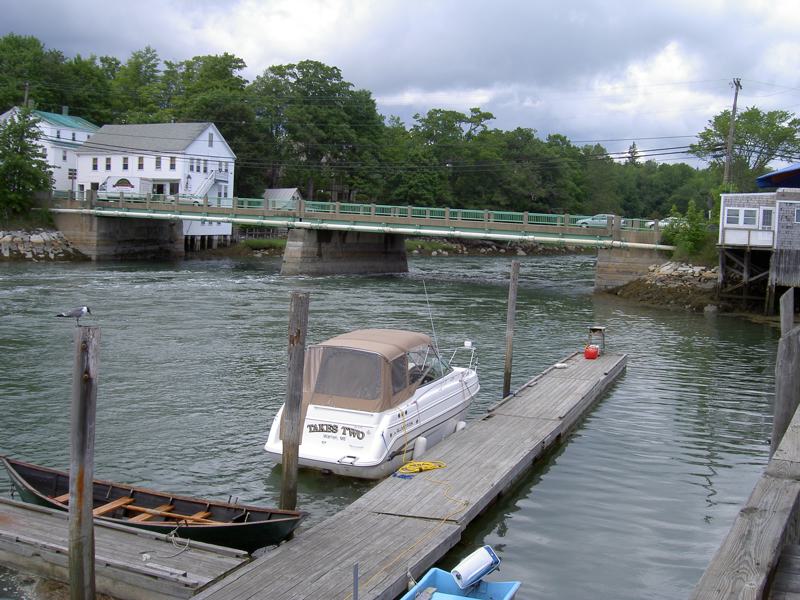
In our wanderings to and fro, hither and yon, high and low, in search of truth, justice, and the American way on your behalf, we encounter all sorts of interesting people and information. Such are the consequences of an insatiable thirst for knowledge, or from another perspective, the curse of an active mind.
Occasionally, we're fortunate to make acquaintances with someone exceptionally qualified to illuminate us on a subject area falling within Side's editorial sphere of interest, but beyond Side's sphere of expertise. This happened recently, thanks to our fine working relationship with a certain State Senator. You shouldn't have to guess who it is.
We're happy now to know George Betke, a railroad and transit professional who resides here in Maine. Following some discussion, we said we'd be happy to publish a contribution from him as a “guest offering,” and he readily agreed to provide one.
We gladly present if for your edification, and will append a few observations of our own at the end of his essay.
(Ed Note: as is our wont, we’ve interspersed some graphics of our own choosing in George’s text. We trust he “won’t” be too flustered by our doing so.)
Dear Mr. Schaeffer:
This commentary addresses most of the questions you posed in a June 7 telephone inquiry about my knowledge of Amtrak’s “Downeaster” and the Northern New England Passenger Rail Authority’s (“NNEPRA’s”) intention to locate an equipment-maintenance facility in Brunswick. As a railroad professional, I am highly sympathetic to residents’ concerns about the noise, odor and visual impact of a large industrial activity in a suburban neighborhood.
Aside from the Town’s defense of the proposed layover complex, however, this proposition raises several larger issues for consideration, and your blog is an appropriate medium for stimulating broader and deeper discussion.
The most directly pertinent is “Why does Amtrak need a 60,000-square-foot, $12-million-plus train-servicing center in Brunswick, Maine?” The designed structure is large enough to accommodate three full train sets (locomotives and passenger cars) under roof and with seasonal heat, a luxury many big-city commuter agencies would covet. Though locomotives require cover and underground pits for periodic inspections and maintenance, available trackside devices can reduce idling by keeping engine oil warm in severe winter conditions.
Passenger coaches are routinely stored in the open throughout the country (as now at Portland) and moved indoors when mechanical or electrical repairs are in order. Daily interior car cleaning can be performed outside, and the job-creating difference between an indoor and outdoor approach to servicing is negligible.
A far less expansive and expensive building (say 10,000 square feet) should suffice for the “Downeaster’s” normal servicing requirements and also be suitable for less controversial local sites. With two track bays, the space could be designed to hold any combination of up to four locomotives or railcars simultaneously, including parts storage and a modest office.
Moreover, if passenger service ever is extended beyond Brunswick, if Amtrak rethinks its business model for outlying services, or if the State should conclude that its ongoing subsidy burden is untenable, the proposed shop could become a colossal and embarrassing single-purpose “white elephant.”
From a passenger-service standpoint, heralded “Downeaster” success calls for serious analysis in contemplating any envisioned expansion. Financial responsibility for the route falls disproportionately on Maine in terms of patronage distribution, much of which is attributable to New Hampshire and Massachusetts. Competing bus operators offer greater service frequency and more convenient Boston connections from Portland.
First-year rail traffic at Brunswick, 52,000 according to press reports, therefore averaged about 1,000 a week, or roughly 24 passengers per trip, a figure inflated by promotional-fare discounts that diluted associated revenue. Those riders represent barely one-third the capacity of a single coach in Amtrak’s normal four-car passenger train and half that of an inter-city bus. This equipment mismatch makes no sense and increases the State’s commitment to subsidize the route, an obvious problem when economic activity is slow and funding limited.
The original Portland-Boston “Downeaster” has the appearance of a successful operation, but the service value added by its 29-mile extension from Portland to Brunswick last year is debatable, specifically as to how the added traffic affects Maine’s subsidy obligation.
Like Amtrak’s “Vermonter” and “Ethan Allen,” such route extensions into less populated areas must be justified largely on political grounds rather than economics (and on related upgrading of trackage also used for freight movements where that factor is relevant). As at Brunswick, standardized Amtrak train sets typically arrive at and depart from St. Albans and Rutland, Vermont with a low complement of passengers. Both of those routes are operated on a once-a-day schedule.
Though reported first-year ridership was a minor fraction of planners’ projections, NNEPRA’s stated objective is to increase Brunswick service frequency to five daily Boston round trips. Is the presumed benefit of such a schedule illusory?
We need to look closely at ridership experience to date – on a time-of-day, day-of-week, directional and seasonal basis – to see how the traffic is concentrated. Another relevant question is how many and when people were induced to ride by promotional fares for seniors, minors, infants, students, multi-ride pass holders, and group travelers.
In other words, a 24-passenger average count per trip is comprised of sharp peaks and valleys reflecting trains that may generate reasonable revenue and others that are hopeless losers. (Overall “Downeaster” revenues are said to cover about 55% of annual operating expenses.) In my view, Amtrak’s present business model inevitably must be modified to deal differently with its outlying state-supported services, which also casts doubt on the prudence of committing to a 60,000-square-foot maintenance facility at Brunswick.

A review of the “Downeaster’s” pricing structure is instructive. Remarkably, the round-trip fare from either Brunswick to Boston in each category is identical to the one-way charge ($29.00, $34.00 or $38.00, depending on class of service), so the return trip produces no added income. Since the differential between Brunswick and Portland is only $4.00, a round-trip traveler to Boston generates just $2.00 each way in ticket revenue for the 29 route-miles beyond Portland, which does not even cover the allocated cost of fuel.
More to the point, why would anyone purchase a one-way ticket, and is the reported passenger count based on ticket sales or actual patronage?
These calculations mean that the 52,000 one-way trips reported for the first 12 months of “Downeaster” operation to Brunswick generated only $104,000 or so of incremental ticket revenue at the standard adult value rate (unadjusted for premium or discount fares), or roughly
$2,000 a week and $50 per trip. The extended route may be a nice public amenity to have available, but it clearly is an expensive luxury at that level of utilization.
A price comparison with Concord Coach is also interesting. The bus is competitively priced in the Portland-Boston corridor while offering greater service frequency and direct connections to other transportation at South Station and Logan Airport. (Concord operates 16 scheduled daily trips from Portland to South Station and 15 to the airport, eight of which are express runs, and one or two from Brunswick, depending on the season). Portland-Boston adult fares are $22.00 one way and $36.00 round trip ($32.00 for a same-day return), giving one-way passengers reason to take the bus.
It seems unlikely that there is much commuter traffic between Brunswick and Portland by either rail or bus. The “Downeaster” is priced at $11.00-20.00, one way and round trip, but the present Boston-oriented connecting schedule is not conducive to short-haul intrastate travel. Could a more frequent and Portland-centric schedule attract a higher complement of local passengers?
The inescapable conclusion is that NNEPRA has offered pricing incentives to achieve an average load factor of around 10% on its six daily Brunswick trains. It is hard to believe that an increase to 10 scheduled runs (five each way) would significantly alter this result.
Since the train shares its Portland terminal with Concord Coach, a more logical solution would be to add Brunswick-Portland bus trips – or substitute more fuel-efficient buses or self-propelled railcars for the present train schedule on that route segment (a less expensive bus is now being used for a midday round trip). It all depends on how “Downeaster” success is measured, and how much we can afford to spend. Maine is paying a substantial premium for the train to match a single-seat bus ride.

NNEPRA’s plan for Brunswick strikes me as a case of wasteful “empire building” in pursuit of an unnecessarily costly and obtrusive ideal. Money is scarce and not free, and construction of the proposed facility under such conjectural and problematic circumstances demands stronger justification than has so far been presented.
George C. Betke, Jr., President
Transport Economics, Inc.
Newcastle, ME 04553-0295

Editor's end-notes:
-
The author cites a “$12 million plus” estimate for MLF construction, which is likely the only number NNEPRA will publicly acknowledge. There is ample justification, however, to expect that actual costs will likely be in the $16-20 million range
-
Mr. Betke makes a case that the net incremental Downeaster revenue for adding the Portland to Brunswick service is in the range of $100,000 a year, which is a horrible business proposition. We have no idea what the marginal operating expenses to cover the service are, but we have no doubt they exceed that number by a lot. We estimated in this post http://othersideofbrunswick.blogspot.com/2014/01/like-weve-said-before-its-good-to-be.html that the contract with Brunswick Taxi for running crews back and forth to Portland, which requires two round-trips daily, 365 days per year, alone could run in the range of $200,000 annually. And no one has yet to correct that estimate or take issue with it.
-
Add to the above that the town of Brunswick spends about $100,000 annually to maintain the station platform and parking lot, and to subsidize the “Departure Center.” Freeport must spend a similar amount. All in all, the Portland to Brunswick service is at best a 'loss leader' in an overall Downeaster deficit operation.

No comments:
Post a Comment